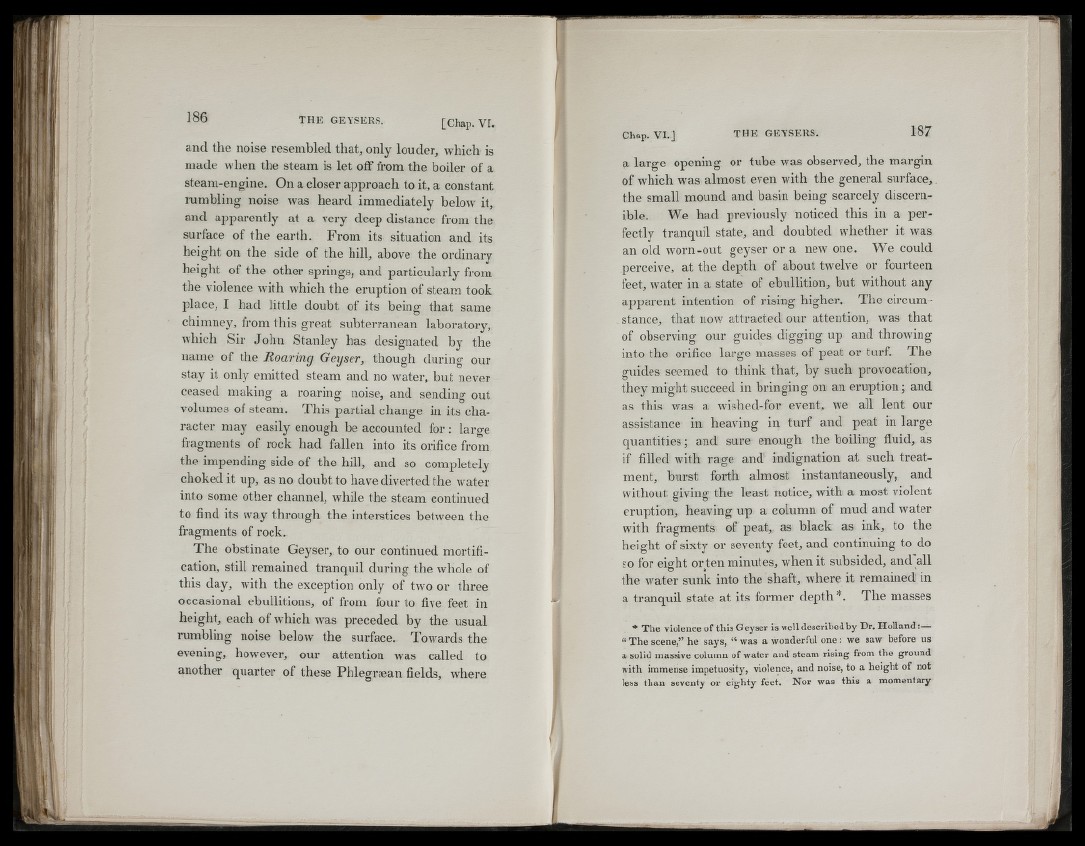
and the noise resembled that, only louder, which is
made when the steam is let off from the boiler of a
steam-engine. On a closer approach to it, a constant
rumbling noise Avas heard immediately beloAA' it,
and apparently at a very deep distance from the
surface of the earth. From its situation and its
height on the side of the hill, above the ordinary
height of the other springs, and particularly from
the violence Avith Avhich the eruption of steam took
place, 1 had little doubt of its being that same
chimne}', from this great subterranean laboratory,
Avhich Sir John Stanley has designated by the
name of the Roaring Geyser, though during our
stay it only emitted steam and no Avater, but never
ceased making a roaring noise, and sending out
volumes of steam. This partial change in its character
may easily enough be accounted for : large
fragments of rock had fallen into its orifice from
the impending side of the hill, and so completely
choked it up, as no doubt to have diverted the water
into some other channel, Avhile the steam continued
to find its Avay through the interstices betAveen the
fragments of rock.
The obstinate Geyser, to our continued mortification,
still remained tranquil during the Avhole of
this day, Avith the exception only of two or three
occasional ebullitions, of from four to five feet in
height, each of which AA'as preceded by the usual
rumbling noise beloAV the surface. ToAvards the
CA'cning, however, our attention was called to
another quarter of these Phlegræan fields, where
Chap. VI.J THE GEYSERS. 187
a large opening or tube was observed, the margin
of which was almost even with the general surface,
the small mound and basin being scarcely discernible.
We had previously noticed this in a perfectly
tranquil state, and doubted whether it Avas
an old worn-out geyser or a new one. We could
perceive, at the depth of about twelve or fourteen
feet, water in a state of ebullition, but without any
apparent intention of rising higher. The circumstance,
that now attracted our attention, Avas that
of observing our guides digging up and throwing
into the orifice large masses of peat or turf. The
guides seemed to think that, by such provocation,
they might succeed in bringing on an eruption; and
as this Avas a Avished-for event, we all lent our
assistance in heaving in turf and peat in large
quantities; and sure enough the boiling fluid, as
if filled with rage and indignation at such treatment,
burst forth almost instantaneously, and
Avithout giving the least notice, with a most violent
eruption, heaving up a column of mud and Avater
with fragments of peat, as black as ink, to the
height of sixty or seventy feet, and continuing to do
£0 for eight oirten minutes, when it subsided, and'all
the Avater sunk into the shaft, where it remained in
a tranquil state at its former depth*. The masses
* T h e violence of this Geyser is well described by Dr. H o llan d :—
" The scene,” he says, “ ■was a wonderful one : we saw before us
a solid massive column of water and steam rising from the ground
with immense impetuosity, violence, and noise, to a height o f not
less than seventy or e igh ty feet. Nor was this a momentary
/